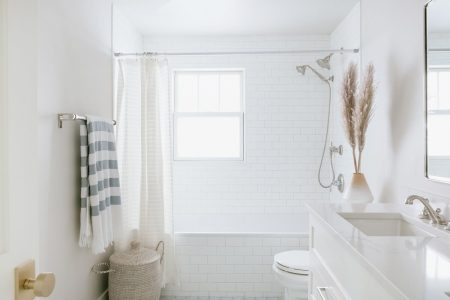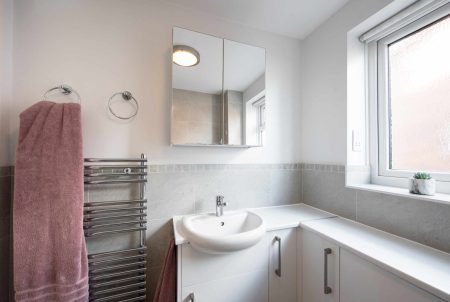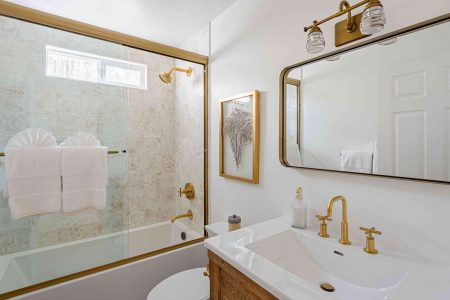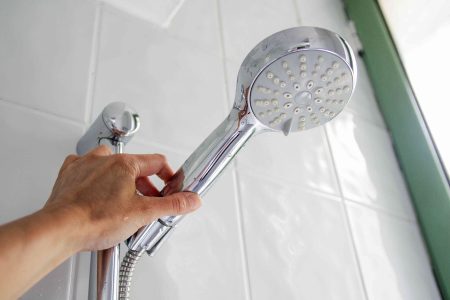A kitchen faucet is a must-have item in the kitchen since it provides running water for dishes, hand-washing, and food prep. Choosing a kitchen faucet might sound as easy as choosing a style you like best, but there are quite a few key factors to consider to ensure the faucet meets your needs and is compatible with your sink style. Allison Ruda, an interior design professional, offers this advice to homeowners: “Sink configuration plays a big role when selecting the right faucet for your space. The sink and the faucet have to work together. Your sink can dictate the type of mount you’ll need.” In addition, proportion is important. “For example, if you have a large farmhouse sink, a taller faucet with a pull-down sprayer would look great and provide balance.”
From swivel spouts to pot fillers, learn the differences between the 12 primary types of kitchen faucets available.
Meet the Expert
Allison Ruda is a Midwest interior designer with experience creating living spaces that are both stylish and timeless for her clients. A graduate of the Interior Design Institute, she has worked with clients in the metropolitan markets of Chicago and Detroit and has had her work featured by publications such as HGTV and Chairish.
-
01
of 12Single-Handle Faucet
Best for: Limited space and ease of use
A single-handle faucet uses one handle that can be turned side to side and up and down to control both the temperature and the water flow with one motion. This is great for turning on water with one hand, making it easy to access water quickly. The single handle design also cuts down on the number of holes that need to be present on the sink itself, making these types of faucets great for tight spaces. The downside to single-handle faucets is that it can be difficult to get a precise temperature or water flow.
-
02
of 12Double-Handle Faucet
Best for: Precise temperature and flow control, larger spaces
A double-handle faucet has a separate handle for cold and hot water flow. This makes controlling temperature and water pressure much more precise. The larger design of this kitchen faucet requires at least three holes in the sink, and possibly more if you wish to add a sprayer or other accessories.
-
03
of 12Pot Filler Faucet
Best for: Extra utility sink or separate water supply
Pot filler faucets are usually mounted to the wall and have jointed arms that allow them to be pushed back out of the way or pulled forward to fill a large pot. These often do not accompany a sink basin, though they can. A pot filler can be used in conjunction with an extra utility sink or to create easy access to a separate water supply, such as over the stove.
-
04
of 12Bridge Faucet
Best for: Large sink area and creating a focal point
Bridge faucets have a separate handle designated for the hot and cold water that are connected to the spout with a horizontal bar, or bridge. This gives these faucets their unique look and name. These are perfect for larger sinks since they require at least two and often three or more holes in the sink basin. They also add a focal point to the room with their unique design.
Continue to 5 of 12 below. -
05
of 12Gooseneck Faucet
Best for: Open sinks and cleaning large objects
Gooseneck faucets are known for their high arch, very similar to the shape of a real goose’s neck. These faucets are vertical to the sink, reaching up and then curving back down into the sink. Their tall height makes them perfect for cleaning large objects. However, these faucets require an open sink area, as their height may not work if the sink is located under cabinetry or window sills.
-
06
of 12Straight Spout Faucet
Best for: Sinks that are tucked under cabinets that do not have much height clearance
Straight spout faucets are designed to reach out horizontally over the sink, remaining a straight line. They are available in a variety of sizes, making them compatible with large and small sinks. Because of their low profile, these faucets are great for sinks that do not have much height clearance, such as sinks tucked under cabinetry.
-
07
of 12Pull-Out Spout Faucets
Best for: Wide sinks and thorough washing or rinsing
A pull-out spout faucet is designed to double both as a stationary faucet and as a handheld sprayer and hose. Simply grasp the faucet and pull it out to reveal the hose and easily move the water wherever it needs to go. Pull-out faucets often have a spray feature built into the faucet handle. These are great for wide sinks, as you can pull out the faucet to reach the edges. They are also ideal for thoroughly rinsing and washing items.
-
08
of 12Pull-Down Spout Faucet
Best for: Deep sinks and thorough washing or rinsing
A pull-down spout faucet also acts as a stationary faucet with a built-in sprayer and hose, although pull-down spout faucets extend down into the sink, rather than out as a handle. These faucets do not have a large handle to grip but still provide easy maneuverability. Pull-down spout faucets are ideal for deep sink basins since they can reach deep into them. This also makes it easier to thoroughly rinse and wash large items.
Continue to 9 of 12 below. -
09
of 12Touchless Faucet
Best for: Reducing messes and making the sink easy to use
Touchless faucets can be turned on with motion and only have one handle to control the temperature of the water. These faucets are perfect for keeping your sink clean and simple. They reduce messes since you do not need to touch the faucet when your hands are dirty. And their streamlined design keeps the sink simple. Some models are smart kitchen faucets that can also be controlled using a voice assistant. However, these high-tech faucets are usually more costly.
-
10
of 12Touch-Activated Faucet
Best for: Easy accessibility and water conservation
Touch-activated faucets are turned on by simply tapping the faucet spout while the temperature is controlled by a small handle on the side of the faucet. Similar to the touchless faucet in design, these faucets are great for keeping sinks simple and streamlined. Because they can be turned on with a simple tap, touch-activated faucets are great for accessing water easily and quickly and can be great for children who may have a hard time reaching the handles of other sinks. However, similar to touchless faucets, touch-activated faucets are usually more expensive than other styles.
-
11
of 12Stationary Faucet
Best for: Small sinks and simple features
Stationary faucets do not move, swivel, or have extra features. They are stationary and offer the simplest form of faucet available. These are great for small sink basins that do not require long-reaching or movable spouts.
-
12
of 12Swivel Spout Faucet
Best for: Wide or double basin sinks
Swivel spout faucets can swivel back and forth, enabling the water flow to be moved. This feature is ideal for wide or double sink basins, as the spout can be moved to either basin depending on where it is needed.
Choosing a Kitchen Faucet
By focusing on what you need your new faucet to accomplish, you can quickly narrow down your choices and find a faucet that fits both your wants and your needs. Do you value a faucet that is easy to use? A touchless faucet may be your best choice. Are you more concerned with getting a precise water temperature and flow? A double-handle faucet can give you the precision you are looking for. Are you looking for a faucet to reach every corner of your large sink basin? A pull-out or pull-down faucet will make rinsing your large sink basin a breeze.
Besides this, it is important to keep in mind the configuration of your sink basin. Whether you are purchasing a new sink basin or installing your faucet into a sink you already own, make sure the faucet is compatible with the number of holes the sink basin has. Some simple faucets, like the single-handle faucet, may only need one to two holes. On the other hand, double handle faucets need at least three holes in the sink basin. It is not advised to drill another hole if your sink basin does not have enough predrilled, so it is important to be sure the faucet and sink are compatible before purchasing. If there are too many holes, deck plates or covers can be used to cover them up.
And lastly, keep in mind the style of your kitchen and existing appliance finishes. Matching the finishes of your other appliances will help keep the room harmonious. Some styles mix and match finishes, though it is best to keep to two different finishes in one room to avoid a disjointed feeling, according to Allison.
Read the full article here














